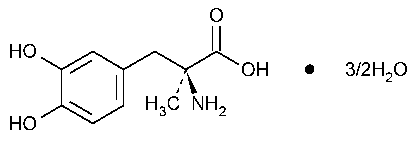Methyldopa
L-Tyrosine,3-hydroxy-a-methyl-,sesquihydrate.
L-3-(3,4-Dihydroxyphenyl)-2-methylalanine sesquihydrate [41372-08-1].
Anhydrous 211.22 [555-30-6].
»Methyldopa contains not less than 98.0percent and not more than 101.0percent of C10H13NO4,calculated on the anhydrous basis.
Packaging and storage—
Preserve in well-closed,light-resistant containers.
Identification—
A:
Infrared Absorption á197Mñ.
B:Ultraviolet Absorption á197Uñ—
Solution:
40µg per mL.
Medium:
0.1Nhydrochloric acid.
Absorptivities at 280nm,calculated on the anhydrous basis,do not differ by more than 3.0%.
C:
To 10mg add 0.15mLof a solution of ninhydrin in sulfuric acid (1in 250):a dark purple color is produced within 5to 10minutes.Add 0.15mLof water:the color changes to pale brownish yellow.
Specific rotation á781Sñ:
between -25 and -28
and -28 .
.
Test solution:
44mg per mL,in a solvent that is a solution of aluminum chloride in water (2in 3)which previously has been treated with activated charcoal,filtered,and adjusted with 0.25Nsodium hydroxide to a pHof 1.5.
Acidity—
Dissolve 1.0g in carbon dioxide-free water with the aid of heat,add 1drop of methyl red TS,and titrate with 0.10Nsodium hydroxide to a yellow endpoint:not more than 0.50mLis required.
Water,Method Iá921ñ:
between 10.0%and 13.0%.
Residue on ignition á281ñ:
not more than 0.1%.
Heavy metals,Method IIá231ñ:
0.001%.
Limit of 3-O-methylmethyldopa—
Developing solvent—
Mix 65parts by volume of butyl alcohol,15parts by volume of glacial acetic acid,and 25parts by volume of water.Prepare this mixture fresh.
Chromatographic plate—
Prepare a thin-layer chromatographic plate with a suitable grade of cellulose,250µm thick,prewashed with the Developing solvent.Wash the plate by placing it in a tank containing the solvent system and allowing the solvent to rise to the top of the plate.Dry with the aid of a current of dry air.
Spray solution 1—
Dissolve 300mg of p-nitroaniline in 100mLof 10Nhydrochloric acid (Solution A).Dissolve 2.5g of sodium nitrite in 50mLof water (Solution B).Mix 90mLof Solution Aand 10mLof Solution B(Spray solution 1).Prepare all solutions fresh,just before spraying.
Spray solution 2—
Dissolve 25g of sodium carbonate in 100mLof water,and mix.
Test solution—
Dissolve 100mg of Methyldopa in methanol,and dilute with methanol to 10.0mL.
Standard solution—
Dissolve 5.0mg of USP3-O-Methylmethyldopa RSin methanol,and dilute with methanol to 50.0mLto obtain a Standard solution having a known concentration of 100µg per mL.
Procedure—
Apply 20µLof the Test solutionin two 10-µLincrements and 10µLof the Standard solutionto the Chromatographic plate,so that the spots are not larger than 0.5cm in diameter.Develop the chromatogram using the Developing solventuntil the solvent front has moved about 10cm from the origin.Remove the plate from the chamber,and dry with the aid of a current of dry air until no odor of acetic acid is perceptible.Place the plate in a vertical position,and evenly spray with Spray solution 1until the adsorbent layer is uniformly soaked down to the glass (do not overspray).Place the plate in a horizontal position,and dry as completely as possible with the aid of a current of warm dry air (no odor of hydrochloric acid is perceptible).Place the plate in a vertical position,and evenly spray with Spray solution 2until the plate is uniformly wet (do not overspray).The major methyldopa spot is black on a pale pink or orange background at an RFvalue of about 0.50,and the 3-O-methylmethyldopa spot is dark on a similar background at an RFvalue of about 0.65.The area and intensity of any 3-O-methylmethyldopa spot from the Test solutionare not greater than those from the Standard solution(0.5%).
Organic volatile impurities,Method Vá467ñ:
meets the requirements.
Solvent—
Use dimethyl sulfoxide.
Assay—
Dissolve about 200mg of Methyldopa,accurately weighed,in 25mLof glacial acetic acid,with the aid of heat.Cool to room temperature,and add 0.1mLof crystal violet TSand 50mLof acetonitrile.Titrate with 0.1Nperchloric acid VSto a blue endpoint.Perform a blank determination,and make any necessary correction.Each mLof 0.1Nperchloric acid is equivalent to 21.12mg of C10H13NO4.
Auxiliary Information—
Staff Liaison:Andrzej Wilk,Ph.D.,Senior Scientific Associate
Expert Committee:(PA5)Pharmaceutical Analysis 5
USP28–NF23Page 1258
Pharmacopeial Forum:Volume No.28(3)Page 769
Phone Number:1-301-816-8305
